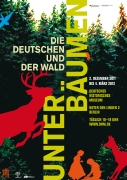

Forest Arts
The Germans as “forest people” successfully attacking their enemies from the woods – such attributes deriving from Roman sources became increasingly popular at the end of the 18th century.
It was above all the occupation of Germany by Napoleon’s troops and the subsequent “Wars of Liberation” (1813–1815) that fostered the Germans’ longing for political independence – and the transformation of the forest into a national symbol.
At first literature fashioned the perception of the forest. Deeply rooted in Romanticism and at one with its motifs, poets, fairytale collectors and soon artists and composers shaped the rampant interpretations of a “German” forest.
From then on poetry, music and painting inspired each other. We find patriotic themes there side by side with images from fairytales and nature as well as atmospheric pictures. Nowadays artists tend to treat the “German” forest with ironic detachment.
